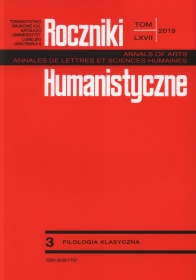Dual Number in the Archaic Latin Poetry
Abstract
The archaic epitaph of Lucius Cornelius Scipio (son of Barbatus), consul of 259 BC, contains the Old Latin form Tempestātēbus (in the dative), referring probably to two goddesses of weather (CIL I2 9). This theonym proves the existence in the Old Latin language of the dual formation *Tempestātē ‘two deities of weather’. The word aide, attested in the epitaph of Scipio, son of Barbatus, can be easily interpreted as a possible form of the dual number, namely *aideē (nom.-acc. du. f.) ‘a bipartite (two-sided) temple; a sacral building with two sanctuaries’. Livius Andronicus used some forms of the dual number in his Latin translation of Homer’s Odyssey, among others genū (nom.-acc. du. n.) ‘two knees’ (fr. 14), inque manū (acc. du. f.) ‘and to both hands’ (fr. 5). It is not known, however, whether the use of the dual number in Andronicus’ Odussia was consistent or optional. Naevius introduced some dual forms into the epic work of Bellum Punicum, e.g. hōc Samnītē ‘these two Samnites’ (fr. 36). It seems, however, that the poet did not do it consistently. The metrical and linguistic analysis of the preserved fragments does not give a definite answer as to whether the use of forms of the dual number was obligatory in Naevius’ work, or was the result of the free choice of the Roman poet. In some passages passed down through indirect tradition, it was easy to arrive at the secondary plurality of the old dual forms.
References
Appel W., O nietypowym znaczeniu dualisu, „Meander” 38(1983), s. 319-327.
Appel W., Zagadka syren. Filologa peregrynacje od antyku do współczesności, Toruń: Wydawnictwo Naukowe Uniwersytetu Mikołaja Kopernika 2017.
Bernardi Perini G., Due problemi di fonetica latina: I. Muta cum liquida, II. S finale, Roma: Edizioni dell’Ateneo 1974.
Chantraine P., Grammaire homérique, t. II: Syntaxe, Paris: Librairie C. Klincksieck 1953.
Cn. Naevii Belli Punici carminis quae supersunt, red. W. Strzelecki, Lipsiae: B.G. Teubner 1964.
Cuny A., Le nombre duel en grec, Paris: Librairie C. Klincksieck 1906.
Fragmenta poetarum Latinorum epicorum et lyricorum praeter Ennium et Lucilium, red. Blänsdorf J., Stutgardiae et Lipsiae: B.G. Teubner 19953.
Giannini S., Un problema di fonosintassi del latino: la consonante -s finale, „Studi e saggi linguistici” 26(1986), s. 111-136.
Meillet A., L’emploi du duel chez Homère et l’élimination du duel, „Mémoires de la Société de Linguistique de Paris” 22(1922), s. 145-164.
Remains of Old Latin, vol. IV: Archaic Inscriptions, red. E.H. Warmington, London: William Heinemann Ltd.–Cambridge, MA: Harvard University Press 19593.
Richardson L., jr.: A New Topographical Dictionary of Ancient Rome, Baltimore–London: The Johns Hopkins University Press 1992.
Strzelecki W., Zarys metryki łacińskiej, w: Metryka grecka i łacińska, red. M. Dłuska, W. Strzelecki, Wrocław: Zakład Narodowy imienia Ossolińskich, Wydawnictwo PAN 1959, s. 72-139.
Viti C., Dual, w: Encyclopedia of Ancient Greek Language and Linguistics, t. I, red. G.K. Giannakis, Leiden–Boston: Brill 2014, s. 533-534.
Viti C., The Use of the Dual Number in Homeric Greek, w: Akten der XIII. Fachtagung der Indogermanischen Gesellschaft vom 21. bis 27. September 2008 in Salzburg, red. T. Krisch, T. Lindner, Wiesbaden: Reichert Verlag 2011, s. 599-604.
Witczak K.T., Pozostałości liczby podwójnej w języku łacińskim epoki archaicznej, „Roczniki Humanistyczne” 65(2017), z. 3, s. 37-58.
Copyright (c) 2019 Roczniki Humanistyczne

This work is licensed under a Creative Commons Attribution-NonCommercial-NoDerivatives 4.0 International License.





